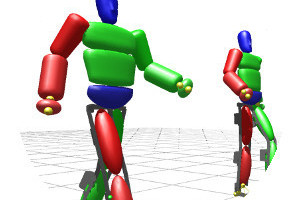
Ein EU-Forschungsprojekt ist dem Laufverhalten des Menschen auf der Spur. Die Analysen sollen den Gang von Roboter verbessern. Zuletzt wurde am Workshop “Robotics in the 21st Century” vom Projekt “KoroiBot” berichtet.

The goal of the KoroiBot project is to enhance the ability of humanoid robots to walk in a dynamic and versatile fashion in the way humans do. Research and innovation work in KoroiBot will mainly target novel motion control methods for existing hardware, but it will also derive optimized design principles for next generation robots.
By doing so, KoroiBot addresses the ambitious goals set for the humanoid robots of the 21st century which are supposed to work and replace humans e.g. in households, disaster sites or space missions but which still lack the very fundamental ability to walk in a human-like fashion. Compared to all the intelligence that humanoids have to acquire to perform these tasks, the demand for an improved walking performance seems simple, but it is in fact very challenging, and the motion abilities of contemporary humanoids are still far behind their human role models. Human gaits are at the same time efficient, robust and versatile but gaits of humanoids or bipedal robots are at best good in one of these areas. This problem is not only linked to the present hardware, but also to a large extent to the control principles and the software used.
The KoroiBot project will address this problem by developing novel software techniques for increased walking performance and evaluating them on the partners’s existing humanoids. To fully demonstrate the capabilities of the software, a prototype design of a new robot will be developed to be exploited by our industrial end users after the end of the project.
The new software technologies are based on mathematical models and methods, in particular optimization, and learning from biology, that will help to increase humanoid walking performance. Especially for humanoid robots with their redundant DoF, optimization is the solution to make the redundancy a benefit rather than a burden.
The KoroiBot methodology is based on the following pillars:
Investigation of human walking by experiments, extraction, motion primitives mathematical models as well as an identification of walking principles
Development of adequate transfer rules
Development of novel optimization and learning based control approaches for walking for humanoids, assembly of a walking alphabet;
Integration of these techniques on several robots.
We study different walking tasks in this project: walking on level ground and uneven terrain, on balance bars and step stone bridges, in interactions with other people, as well as multi-contact walking with additional hand supports and push recovery. This is only possible by a truly interdisciplinary approach combining expertise in humanoid robotics, mathematics, cognitive sciences and biomechanical modeling.
Beyond the scope of humanoids, the methods can be useful for the design and control of exoskeletons and intelligent prostheses, in functional electrical stimulation of hemiplegic or paraplegic patients, biped-based novel transportation systems or in computer animations and games.
Quelle: KoroiBot
